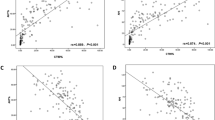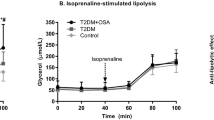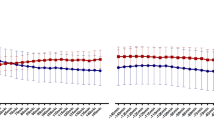Abstract
The purpose of this study was to investigate the possibility of a relationship between the severity of obstructive sleep apnea syndrome (OSAS) and adaptive thermogenesis. Daily energy expenditure (DEE) and sleeping metabolic rate (SMR) were measured in apneic and a priori nonapneic subjects who were tested in a whole-body indirect calorimetry chamber for 24 h. The apneic patients were diagnosed by nocturnal home oximetry to determine the percentage of total recording time spent below 90% arterial oxygen saturation (% TRT <90% SaO2). Reference equations established from body weight and age in nonapneic subjects were used to predict DEE and SMR in apneic patients. The predicted values of the apneic patients were then compared to their measured values. No significant difference was found between predicted and measured values in SMR nor in DEE. We observed a significant relationship between the severity of nocturnal desaturation and the difference between predicted and measured DEE in apneic patients (r=−0.74, P<0.05) and a similar negative trend with SMR (r=−0.65, P=0.08). These preliminary data suggest that a nocturnal hypoxia may influence adaptive thermogenesis in apneic patients and complicate their body weight regulation.
This is a preview of subscription content, access via your institution
Access options
Subscribe to this journal
Receive 12 print issues and online access
$259.00 per year
only $21.58 per issue
Buy this article
- Purchase on Springer Link
- Instant access to full article PDF
Prices may be subject to local taxes which are calculated during checkout

Similar content being viewed by others
References
Levinson PD, McGarvey ST, Carlisle CC, Eveloff SE, Herbert PN, Millman RP . Adiposity and cardiovascular risk factors in men with obstructive sleep apnea. Chest 1993; 103: 1336–1342.
Nieto FJ, Young TB, Lind BK, Shahar E, Samet JM, Redline S et al. Association of sleep-disordered breathing, sleep apnea, and hypertension in a large community-based study. Sleep Heart Health Study. JAMA 2000; 283: 1829–1836.
Ip MS, Lam B, Ng MM, Lam WK, Tsang KW, Lam KS . Obstructive sleep apnea is independently associated with insulin resistance. Am J Respir Crit Care Med 2002; 165: 670–676.
Punjabi NM, Sorkin JD, Katzel LI, Goldberg AP, Schwartz AR, Smith PL . Sleep-disordered breathing and insulin resistance in middle-aged and overweight men. Am J Respir Crit Care Med 2002; 165: 677–682.
Chin K, Shimizu K, Nakamura T, Narai N, Masuzaki H, Ogawa Y et al. Changes in intra-abdominal visceral fat and serum leptin levels in patients with obstructive sleep apnea syndrome following nasal continuous positive airway pressure therapy. Circulation 1999; 100: 706–712.
Peppard PE, Young T, Palta M, Dempsey J, Skatrud J . Longitudinal study of moderate weight change and sleep-disordered breathing. JAMA 2000; 284: 3015–3021.
Grunstein RR, Stenlof K, Hedner J, Sjostrom L . Impact of obstructive sleep apnea and sleepiness on metabolic and cardiovascular risk factors in the Swedish Obese Subjects (SOS) Study. Int J Obes Relat Metab Disord 1995; 19: 410–418.
Leung RS, Bradley TD . Sleep apnea and cardiovascular disease. Am J Respir Crit Care Med 2001; 164: 2147–2165.
Phillips BG, Hisel TM, Kato M, Pesek CA, Dyken ME, Narkiewicz K et al. Recent weight gain in patients with newly diagnosed obstructive sleep apnea. J Hypertens 1999; 17: 1297–1300.
Phillips BG, Kato M, Narkiewicz K, Choe I, Somers VK . Increases in leptin levels, sympathetic drive, and weight gain in obstructive sleep apnea. Am J Physiol Heart Circ Physiol 2000; 279: H234–H237.
Traviss KA, Barr SI, Fleming JA, Ryan CF . Lifestyle-related weight gain in obese men with newly diagnosed obstructive sleep apnea. J Am Diet Assoc 2002; 102: 703–706.
Grunstein RR, Handelsman DJ, Lawrence SJ, Blackwell C, Caterson ID, Sullivan CE . Neuroendocrine dysfunction in sleep apnea: reversal by continuous positive airways pressure therapy. J Clin Endocrinol Metab 1989; 68: 352–358.
Brooks B, Cistulli PA, Borkman M, Ross G, McGhee S, Grunstein RR et al. Obstructive sleep apnea in obese noninsulin-dependent diabetic patients: effect of continuous positive airway pressure treatment on insulin responsiveness. J Clin Endocrinol Metab 1994; 79: 1681–1685.
Ip MS, Lam KS, Ho C, Tsang KW, Lam W . Serum leptin and vascular risk factors in obstructive sleep apnea. Chest 2000; 118: 580–586.
Adams R, Victor M, Ropper A . Principles of Neurology 6th edn. McGraw-Hill, Health Professions Division: New York, 1997. pp 1618.
Somers VK, Dyken ME, Clary MP, Abboud FM . Sympathetic neural mechanisms in obstructive sleep apnea. J Clin Invest 1995; 96: 1897–1904.
Tremblay A, Pelletier C, Doucet E, Imbeault P . Thermogenesis and weight loss in obese individuals: a primary association with organochlorine pollution. Int J Obes Relat Metab Disord 2004; 28: 936–939.
White MD, Bouchard G, Buemann B, Alméras N, Després JP, Bouchard C et al. Reproducibility of 24-h energy expenditure and macronutrient oxidation rates in an indirect calorimeter. J Appl Physiol 1996; 80: 133–139.
Stenlof K, Grunstein R, Hedner J, Sjostrom L . Energy expenditure in obstructive sleep apnea: effects of treatment with continuous positive airway pressure. Am J Physiol 1996; 271: E1036–E1043.
Lin CC, Chang KC, Lee KS . Effects of treatment by laser-assisted uvuloplasty on sleep energy expenditure in obstructive sleep apnea patients. Metabolism 2002; 51: 622–627.
Ravussin E, Lillioja S, Knowler WC, Christin L, Freymond D, Abbott WG et al. Reduced rate of energy expenditure as a risk factor for body-weight gain. N Engl J Med 1988; 318: 467–472.
Roberts SB, Leibel RL . Excess energy intake and low energy expenditure as predictors of obesity. Int J Obes Relat Metab Disord 1998; 22: 385–386.
Doucet E, St-Pierre S, Alméras N, Després JP, Bouchard C, Tremblay A . Evidence for the existence of adaptive thermogenesis during weight loss. Br J Nutr 2001; 85: 715–723.
Acknowledgements
This work was supported by the Canada Research Chair in Physical Activity, Nutrition and Energy Balance.
Author information
Authors and Affiliations
Corresponding author
Rights and permissions
About this article
Cite this article
Hins, J., Sériès, F., Alméras, N. et al. Relationship between severity of nocturnal desaturation and adaptive thermogenesis: preliminary data of apneic patients tested in a whole-body indirect calorimetry chamber. Int J Obes 30, 574–577 (2006). https://doi.org/10.1038/sj.ijo.0803159
Received:
Revised:
Accepted:
Published:
Issue Date:
DOI: https://doi.org/10.1038/sj.ijo.0803159
Keywords
This article is cited by
-
Resting energy expenditure in OSAS: the impact of a single CPAP application
Sleep and Breathing (2016)
-
Basal body temperature as a biomarker of healthy aging
AGE (2016)
-
Clinical significance of adaptive thermogenesis
International Journal of Obesity (2007)
-
The effect of topiramate on energy balance in obese men: a 6-month double-blind randomized placebo-controlled study with a 6-month open-label extension
European Journal of Clinical Pharmacology (2007)



